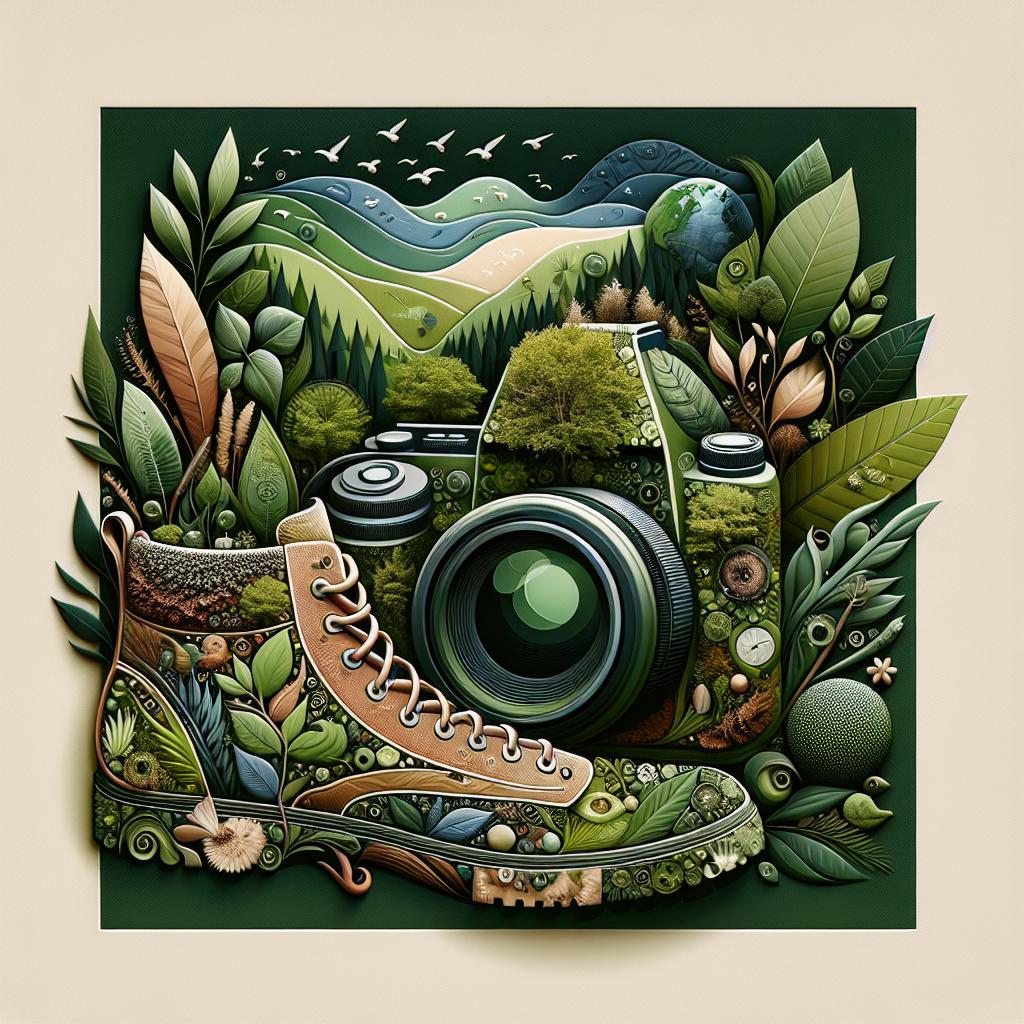In an era where the art of photography gracefully intertwines with the natural world, hiking trails have become sanctuaries of visual delight for those who seek to capture the earth’s untouched beauty. “Hiking Trails for Photography Enthusiasts” unveils a symphony of landscapes as diverse as the colors in a sunset, each path a canvas waiting to be discovered through the lens of a wandering photographer. Whether it’s the gentle rustle of leaves, the play of light on water, or the whispered stories of ancient rock formations, these trails offer more than just a journey through nature—they provide an opportunity to freeze moments of serene grandeur and ethereal wonder. Step into a world where every turn is a new frame, every vista a masterpiece waiting to be immortalized, and let your camera lead you on an expedition through some of the most photogenic trails on our planet.
Capturing the Journey: Essential Gear for Trail Photography
Embarking on a trail with the intention of capturing its raw beauty requires more than just enthusiasm; it demands the right set of gear to truly seize the essence of the landscape. Photography enthusiasts should prioritize lightweight and versatile equipment for their adventures. A full-frame mirrorless camera is ideal, balancing quality with portability. Consider a wide-angle lens to capture expansive vistas, and a telephoto lens for distant details. Don’t underestimate the power of a sturdy tripod; it provides stability for those long exposure shots at sunrise or sunset. A high-capacity memory card and spare batteries are essentials to ensure you don’t miss a moment.
- Mirrorless camera with a wide-angle and telephoto lens
- Lightweight tripod
- High-capacity memory cards
- Spare batteries
In addition to the core photography gear, having accessories that adapt to the unpredictable nature of trails is crucial. A weather-sealed camera bag will keep your equipment safe from unexpected changes in the weather. Consider packing a lens cleaning kit to maintain image clarity during dusty or misty conditions. Incorporating a polarizing filter can greatly enhance contrast and minimize reflections, especially when photographing water bodies or foliage under direct sunlight. Also, a smartphone with GPS mapping applications can be invaluable for navigating tricky terrains and marking locations for repeat visits.
- Weather-sealed camera bag
- Lens cleaning kit
- Polarizing filter
- Smartphone with GPS apps
| Item | Purpose |
|---|---|
| Mirrorless Camera | High-quality images with portability |
| Tripod | Stability for long exposure shots |
| Weather-sealed Bag | Protection against elements |
| Polarizing Filter | Enhances image contrast |

Golden Hour Trails: Best Times for Photography Hikes
The fleeting moments of sunrise and sunset, known as the golden hour, can transform your photography hikes into an ethereal experience. Light at these times is soft, warm, and perfectly diffused, casting a magical glow over landscapes and offering the ideal conditions for capturing stunning photographs. For the early birds, sunrise hikes present a peaceful ambiance, with trails often less crowded and the atmosphere filled with the crisp freshness of a new day. Sunset enthusiasts, on the other hand, are greeted with vibrant hues that paint the sky and create dynamic compositions as the day fades into night. Whichever you choose, these hours provide a unique and captivating canvas for your photography.
- Mount Rainier, Washington – Ideal for capturing the mountain’s majestic profile lit by the golden light.
- Zion National Park, Utah – Awe-inspiring cliffs that come alive with colors as the sun rises and sets.
- Great Smoky Mountains, Tennessee – Offers a misty, dreamlike atmosphere perfect during sunrise.
| Trail | Best Time |
|---|---|
| Angels Landing, Zion | Sunset |
| Skyline Trail, Mt. Rainier | Sunrise |
| Cades Cove, Smoky Mountains | Golden Hour (Dawn) |

Hidden Gems: Lesser-Known Trails with Stunning Vistas
Imagine winding through secluded forest paths or climbing rugged, rocky terrains to uncover nature’s hidden masterpieces, where each twist and turn offers an untold story for your lens. For those with a keen eye for photography, exploring these lesser-known trails provides an unyielding opportunity to capture scenes untainted by the footprints of countless visitors. Art Loeb Trail in North Carolina, for instance, offers a mosaic of breathtaking montane vistas and lush valleys, where the wildflowers bloom with unrestrained freedom. Meanwhile, the Lost Coast Trail along California’s most remote coastline beckons with its raw, untamed landscapes and the haunting beauty of black sand beaches.
Photographers will find a treasure trove of diversity in these scenic pathways. Here are a few trails that deserve a spot on your photography itinerary:
- Artist Point Trail in Wyoming: Known for its panoramic views of the Grand Canyon of the Yellowstone and a marvel of pastel hues during sunrise.
- Maze Overlook Trail in Utah: Offers an intricate labyrinth of canyons and sweeping desert vistas best captured in the soft glow of dusk.
- Valley of Fire Wave Trail in Nevada: Features vibrant red sandstone formations that paint a mesmerizing picture against the stark blue sky.
- Kalalau Trail in Hawaii: Winds along staggering cliffs with glimpses of exotic flora and expansive ocean views.
Discovering these spots offers a sense of adventure and solitude, elements that are often lost in more popular locations. Here’s a brief glimpse into their attributes:
| Trail | Location | Main Attraction |
|---|---|---|
| Art Loeb Trail | North Carolina | Mountain Views |
| Lost Coast Trail | California | Black Sand Beaches |
| Artist Point Trail | Wyoming | Canyon Views |
| Maze Overlook Trail | Utah | Canyon Labyrinth |

Eco-Friendly Hiking: Leave No Trace in Natural Photography
Immerse yourself in the breathtaking world of nature while practicing sustainable habits as an eco-conscious photographer. Capturing the essence of a landscape should harmonize with the principles of environmental stewardship. As we journey, it’s crucial we respect the areas we explore by minimizing our ecological footprint. Here are some tips to help you achieve this balance while enhancing your outdoor photography experience:
- Stay on Trails: Straying from marked paths can lead to erosion and habitat disruption. Stick to designated trails to protect delicate ecosystems.
- Carry Out All Waste: Leave nothing behind, not even biodegradable items. Anything foreign can disrupt the natural environment.
- Share with Others: Make sure that your presence doesn’t disturb other hikers or wildlife. Use telephoto lenses to get your shot without encroaching on their space.
To showcase your commitment, consider the following approach to your planning and equipment:
| Equipment | Sustainable Practice |
|---|---|
| Camera Batteries | Use rechargeable options to minimize disposal issues. |
| Tripod | Select lightweight and durable materials to reduce resource use. |
| Backpack | Opt for packs made from recycled or ethical materials. |
Aligning your passion for photography with responsibility towards nature can make your hiking adventures rewarding and sustainable. The beauty of nature is a gift, and preserving it ensures it’s a gift that keeps on giving.
Q&A
Q&A: Hiking Trails for Photography Enthusiasts
Q1: What makes a hiking trail ideal for photography enthusiasts?
A1: An ideal hiking trail for photography enthusiasts combines stunning landscapes, diverse flora and fauna, and unique geological features. Trails that traverse through varied ecosystems, such as forests, mountains, and lakesides, provide photographers with a multitude of subjects and ever-changing light conditions to capture. Accessibility to these trails and seasonal variations, offering something new throughout the year, also enhance the photography experience.
Q2: Can you recommend some top hiking trails around the world for photography?
A2: Certainly! Here are a few must-visit trails for photographers:
- The Inca Trail, Peru: Renowned for its breathtaking views of the Andes and ancient Incan ruins.
- Lofoten Islands, Norway: Offers dramatic mountainous landscapes and the chance to photograph the Northern Lights.
- Torres del Paine, Chile: Known for its stunning glacial scenery and diverse wildlife.
- Yosemite Valley Loop Trail, USA: Famous for its iconic vistas including Half Dome and El Capitan.
- Milford Track, New Zealand: Provides a mesmerizing mixture of rainforests and fjords.
Q3: What equipment would you recommend for photographers on these trails?
A3: Photographers should pack lightweight, durable gear suitable for outdoor conditions. A versatile zoom lens allows for capturing landscapes and close-ups without having to carry multiple lenses. A sturdy tripod is essential for long-exposure shots, such as waterfalls or starry skies. Additionally, polarized filters can enhance colors and reduce glare from water surfaces. Don’t forget ample storage and batteries, as these remote areas might not offer instant recharging options.
Q4: How should photographers prepare for safety while hiking?
A4: Safety is paramount when hiking on photography trips. Photographers should research weather conditions and trail difficulty beforehand, ensuring they are physically prepared for the challenges. Carry essentials such as a first aid kit, a map or GPS device, and enough food and water. Inform someone about your itinerary, and consider going with a group or guide. Proper footwear and clothing suited for the terrain and climate will help prevent injuries.
Q5: Are there ethical considerations photographers should keep in mind while hiking these trails?
A5: Absolutely. Ethical photography is crucial to preserving natural beauty and respecting wildlife. Stay on marked paths to minimize environmental impact and avoid disturbing wildlife by keeping a safe distance. It’s important not to leave any traces of your visit; pack out what you pack in. Adhere to any local regulations, which may include specific rules about drone usage or restricted areas to ensure the safety and preservation of the ecosystem.
Q6: How can amateur photographers enhance their skills while hiking?
A6: Amateur photographers can enhance their skills by embracing the trial and error method. Experiment with different camera settings and compositions to discover what works best for various scenarios. Studying light and how it interacts with the landscape can lead to more dynamic photos. Engaging with photography communities, either online or locally, can provide valuable feedback and insights. Lastly, patience is key—waiting for the perfect moment can transform a good photo into a great one.
In Retrospect
As the sun dips below the horizon and you pack away your gear, the world of hiking trails for photography enthusiasts leaves a lingering imprint on your senses. From the whisper of leaves underfoot to the expansive vistas that took your breath away, these paths offer more than just a walk through nature—they’re a canvas for creative expression. Whether you captured the delicate dance of light across a mountain range or immortalized the fleeting blush of wildflowers, each click of the shutter is a testament to the beauty that surrounds us. As you look back at the snapshots of your journey, remember this: the best pictures are yet to be taken. Nature in all her glory awaits, ready to inspire your next adventure.

